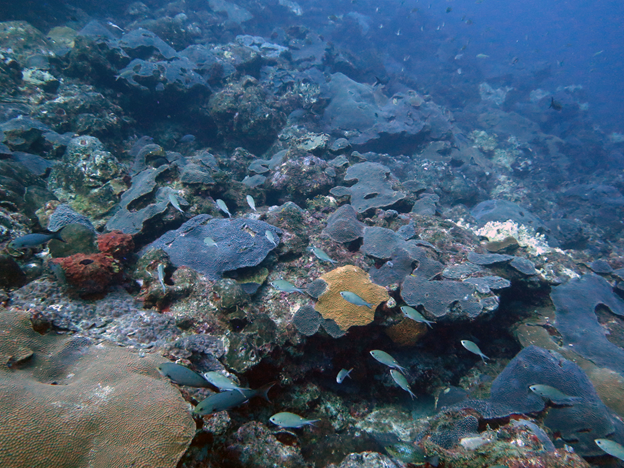NCCOS-funded researchers found that great star coral populations across the tropical western Atlantic Ocean have greater genetic similarities at similar depths than populations between shallow (less than 30 meters) and mesophotic (30 to 150 meters) depths. However, exceptions to this pattern exist within the northwestern Gulf of Mexico and upper Florida Keys, where shallow and mesophotic populations show high genetic connectivity.
Study findings mean a one-size-fits-all solution for managing great star coral populations does not exist and multiple strategies may be required to ensure persistence of the species.
The great star coral (Montastraea cavernosa) is an important reef-building species with broad depth and geographic distribution, making it an ideal species to investigate how populations at different depths and locations may be related or “connected” to each other. The research team used molecular genetics to compare corals living in shallow and mesophotic depths across the northwestern and southern Gulf of Mexico, Florida, Cuba, and Belize.

Montastraea cavernosa is an abundant coral species on shallow and mesophotic reefs, as seen here in the Flower Garden Banks National Marine Sanctuary at a depth of roughly 35 meters. These corals drive productivity and create habitat for economically important fisheries. (Image credit: Dr. Joshua Voss, FAU)
In addition to depth, patterns of genetic similarity or differentiation may be associated with the region’s loop current system functioning as either a barrier or conduit of connectivity among the sampled reefs. This highlights the need for international collaboration in managing these reefs, the inclusion of mesophotic populations in monitoring and management plans, and assessments to determine the ability of populations to reseed themselves across depth ranges or from other reef sources.
The work, led by Florida Atlantic University (FAU), is part of NCCOS’s Regional Ecosystem Research Program and is funded by NCCOS and NOAA’s Office of Ocean Exploration and Research, in collaboration with NOAA’s Office of National Marine Sanctuaries and NOAA’s National Marine Fisheries Service (Southeast Regional Office). The overarching project is investigating population connectivity for key coral, sponge, and fish species in shallow and mesophotic reefs of the Flower Garden Banks National Marine Sanctuary to help managers develop marine protected areas that are effective and benefit present and future generations.



